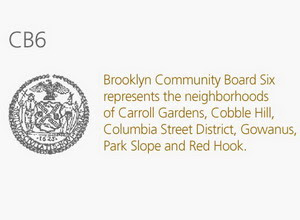Sharp Knives: Markowitz, Yassky and de Blasio Purge Community Board 6
 The final death toll of the Community Board 6 Atlantic Yards Massacre is nine, which is a little less than had been predicted, but a stinging blow to an institution that had raised legitimate questions about the big development and its impact. The list of members that were not reappointed was circulated late yesterday. Together the dismissed members had about 150 years of combined service. The purge was carried out by Borough President Marty Markowitz along with City Council Members David Yassky and Bill de Blasio.
The final death toll of the Community Board 6 Atlantic Yards Massacre is nine, which is a little less than had been predicted, but a stinging blow to an institution that had raised legitimate questions about the big development and its impact. The list of members that were not reappointed was circulated late yesterday. Together the dismissed members had about 150 years of combined service. The purge was carried out by Borough President Marty Markowitz along with City Council Members David Yassky and Bill de Blasio.Mr. Markowitz removed five CB 6 members. Council Member Yassky removed three CB6 members and Council Member de Blasio removed one. Members Jerry Armer, Angela Beni, Bill Blum, Barbara Longobardi and Marilyn Oliva were removed by Mr. Markowitz. Council Member Yassky purged three members--Pauline Blake, Al Cabbad and Theresa Ricks. Mr. de Blasio removed Madelaine Murphy.
Rumors of the purge had been circulating for months as have stories about Mr. Markowitz's often angry (some say screaming and raging) confrontations of CB6 members that opposed Atlantic Yards.
Member Jeff Strabone, whose term is up next year, told the New York Times: “It’s a shame to punish people for having independent judgment. On the one hand, in order to have fresh blood on the board there has to be change, but losing this much leadership at once is a bloodletting.” Atlantic Yards Report offers complete analysis of the dismissals, including the notation that Mr. Armer, who was dismissed, was "hardly a flamethrower."
(It should be noted that we got at least one email from a local activist that called the turnover "healthy," but said that it shouldn't have happened because of opposition to Atlantic Yards.)
Some GL Analysis
What is interesting about the CB6 purge isn't that it happened--that's hardball politics in the big city--but that it again shines a spotlight on the awful Atlantic Yards process. We have long felt that the process was both deeply flawed and largely undemocratic--so much so that few public officials even cared about creating an appearance of bona fide public participation. The CB6 dismissals strengthen the belief that Mr. Markowitz and other supporters were unwilling to tolerate basic legitimate questions about the project's impact on the community or an honest assessment of its public costs. CB6 did its job by raising questions and representing the community.
We understand that politics is politics. When Richard Nixon didn't like the way the Watergate investigation was going, he exercised his Presidential power and fired the investigators. The current Attorney General is in hot water for putting the screws to U.S. Attorneys. At the end of the day, one of the perks of position and power is the ability to fire those whose performance displeases you.
Yet, the CB6 Purge gets to the reasons that Atlantic Yards has had such a sadly divisive and deeply corrosive impact on Brooklyn politics and on civic discourse. One clear culprit has been the absence of real participatory democracy in a project that will impact the quality of life in surrounding communities for generations to come. Had the planning process not been handled as a top-down exercise, the outcome might still have been the same, but some of the bitterness and civic poison might have been diluted. (We remember the huge discussion session held at the Javits Center to get public input about rebuilding of the World Trade Center site. It didn't make a difference in the convoluted planning and development process, but it gave thousands of people a sense that their opinions were being heard.) A real public process would have allowed for an airing of strong feelings and led to real modifications of the proposal that reflected legitimate community concerns. It would have tempered some resentment. It might even--gasp--have led to broader support.
CB6 was one of the institutions that tried to represent community concerns. To have members that raised them symbolically taken out and shot for speaking their minds, is fair political game, we suppose. But it's indicative of the political sickness that surrounds Atlantic Yards. And it will have implications for other important work, like the Gowanus rezoning, in which CB6 is involved.
We remain convinced that a generation from now, someone will be teaching an urban planning course that uses Atlantic Yards as the case study of how not to plan a major public project. In that context, the CB6 Atlantic Yards Massacre will be an interesting footnote.
Related Links:
- Ironies of the CB6 Purge: Jerry Armer, Flamethrower? [AYR]
- Project's Foes Shown Door in Brooklyn [NYT]
- Arena Foes Slam Dunked [NYP]
- Markowitz Boots Board Members [DDDB]
- What Is Community Board 6? [OTBKB]
Labels: Atlantic Yards, Community Boards
0 Comments:
Post a Comment
<< Home